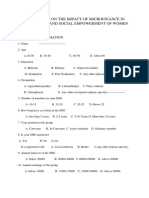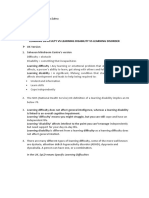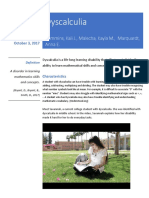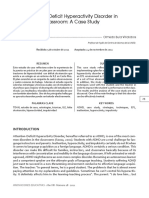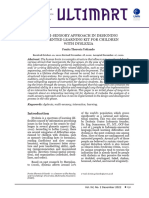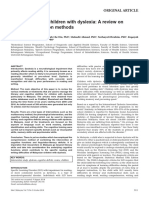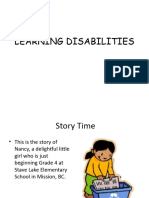Preparation Outline (Informative Speech) : I. Attention Getter II. Iii. IV. V. Stating Established Facts
Preparation Outline (Informative Speech) : I. Attention Getter II. Iii. IV. V. Stating Established Facts
Uploaded by
Nur AthirahCopyright:
Available Formats
Preparation Outline (Informative Speech) : I. Attention Getter II. Iii. IV. V. Stating Established Facts
Preparation Outline (Informative Speech) : I. Attention Getter II. Iii. IV. V. Stating Established Facts
Uploaded by
Nur AthirahOriginal Description:
Original Title
Copyright
Available Formats
Share this document
Did you find this document useful?
Is this content inappropriate?
Copyright:
Available Formats
Preparation Outline (Informative Speech) : I. Attention Getter II. Iii. IV. V. Stating Established Facts
Preparation Outline (Informative Speech) : I. Attention Getter II. Iii. IV. V. Stating Established Facts
Uploaded by
Nur AthirahCopyright:
Available Formats
SAMPLE
UNLOCKING DYSLEXIA
PREPARATION OUTLINE (INFORMATIVE SPEECH)
Name:
ID :
Group :
Title : Unlocking Dyslexia
General Purpose : To Inform
Central Idea : Dyslexia, which could occur in people of all backgrounds and intellectual
levels, can be identified by the problems related to it.
INTRODUCTION
I. Look at these images. These are what a person with dyslexia would see. – Attention getter
II. About 314,000 children in Malaysia are suffering from dyslexia.
III. On average, the Ministry of Education Malaysia reported that there is one dyslexic case
identified in every 20 students.
IV. Sin Chew Daily reported that nearly 10% of the students in primary and secondary school
are affected with the disorder
V. 80% of the diagnoses are dyslexia-related, but some studies indicate that up to 20% of the
population may have some degree of dyslexia. – Stating established facts
IV. People with dyslexia can be very bright and often capable, or even gifted in areas such as
art, computer science, design, drama, electronics, math, mechanics, music, physics, sales,
and sports. - Stating surprising fact
A. There are many famous people who have overcome great hurdles to achieve in their
field, and they are not ashamed to admit their difficulties with dyslexia.
V. Dyslexia, a learning disability which can affect children of all backgrounds and intellectual
levels, can also affect various aspects of their lives. – Central idea (thesis)
(Transition: So, does dyslexia affect more boys or girls? Let’s move on.)
BODY
I. Graph 1 shows the population of dyslexics and non-dyslexics children. - Description
A. 12% of the population are boys while 20% are girls. - Description
B. Although the common impression is that dyslexia impacts a higher number of males
than the females, the reality is that nearly equal numbers of boys and girls have
dyslexia. – Analysis
C. It could be that boys are more likely to be diagnosed.
D. According to both the ADAM Medical Encyclopedia and the Dyslexia Action group,
symptoms of dyslexia only begin to appear around the age of 7 or 8 when a child
begins to learn in school.
E. Dyslexic children may show signs of slow reading rate, difficulty interpreting
meanings in reading and hard time sequencing problems / instructions.
(Transition: Now, let’s look at the causes of dyslexia.)
SAMPLE
UNLOCKING DYSLEXIA
II. Graph 2 depicts the problems of dyslexia which are mostly related to internal factors
instead of external ones. - Description
A. Since dyslexia is characterized by brain processing, dyslexics may reverse letters or
numbers when reading,
B. While people often assume the trouble lies within their vision, many dyslexics do not
actually experience the reversal of symbols.
1. Some dyslexics experience words moving, blurred, or reversed on a
page, but some just have difficulty processing.
2. The charts provide an analysis of problems linked to dyslexia. (12 Frequently
Asked Questions, 2014)
1. 92% of the problem linked to dyslexia is related to memory. - Description
2. It is shown that dyslexics also have sleeping difficulties which is 52%
and needing assistance with reading which is 54%. - Description
3. Problems related to insomnia is a little less than half of those having
sleeping difficulties. - Analysis
CONCLUSION
I. Dyslexia is a disorder, not a disability
II. There are treatments associated with this disorder which enables one to recognize the
dyslexics and provide support. - Summary
A. Dyslexic children need specialized learning. - Recommendation
1. Dyslexics need more attention from teachers or adults to work around their
disadvantage.- Recommendation
a. Teachers and tutors can use a multisensory, structured language
approach.
b. According to Jane Gallagher of the Dyslexia Action group in an April
2011 interview, technology can be used as a learning tool.
– Recommendation
c. Different fonts appear easier to students with dyslexia.
d. The biggest thing other people can offer is encouragement.
III. With so many children being diagnosed with dyslexia, and numerous adults discovering
that they have had the disorder enables them to be recognized and get support.
– Reinforce central idea
IV. You can make the difference by helping the dyslexics feel belong in the community.
– concluding statement
SAMPLE
UNLOCKING DYSLEXIA
References
12 Frequently Asked Questions (2014). https://redefinedyslexia.wordpress. com/2014/11/03/12-
frequently-asked-questions/
Nurul Anis Mohd Yuzaidey et. al (2018). Interventions for children with dyslexia: A review on
current intervention methods. http://www.e-mjm.org/2018/v73n5/children-with-dyslexia.pdf
The International Dyslexia Association (IDA), (2020). Dyslexia Basics. https://dyslexiaida.org/
dyslexia-basics/
Zettler-Greeley, C., (2018). Understanding Dyslexia. https://kidshealth.org/en/parents/
dyslexia.html
SAMPLE
UNLOCKING DYSLEXIA
https://redefinedyslexia.wordpress.com/2014/11/03/12-frequently-asked-questions/
Graph 1
Graph 2
You might also like
- Comm 210 Informative Speech OutlineDocument5 pagesComm 210 Informative Speech Outlineapi-269568046No ratings yet
- Questionnaire On The Impact of Microfinance in The Economic and Social Empowerment of WomenDocument3 pagesQuestionnaire On The Impact of Microfinance in The Economic and Social Empowerment of WomenMariam Mathen62% (13)
- Upright SL20Document56 pagesUpright SL20Jaap MoparNo ratings yet
- DyslexiaDocument37 pagesDyslexiaRycris Mae Dela Peña100% (1)
- Broadbanding Pay StructureDocument11 pagesBroadbanding Pay StructureKrunal Bosamia100% (3)
- Human Resource Managment Case StudiesDocument7 pagesHuman Resource Managment Case StudiesMichael Pamor33% (6)
- Dyslexia OutlineDocument2 pagesDyslexia OutlineAusNo ratings yet
- Understanding Dyslexia1Document37 pagesUnderstanding Dyslexia1Ariel E SJNo ratings yet
- Inclusion of Students With Learning Disabilities in Higher Education Practitioners GuidebookDocument124 pagesInclusion of Students With Learning Disabilities in Higher Education Practitioners GuidebookDhanashree Sawant/RayaanNo ratings yet
- CriticialDocument6 pagesCriticialishanvi0504No ratings yet
- Dyslexia Defined Human Growth Research Paper!Document6 pagesDyslexia Defined Human Growth Research Paper!Sarah PersonsNo ratings yet
- Lesson 3 Exceptionality 20 21Document51 pagesLesson 3 Exceptionality 20 21morales12raquelNo ratings yet
- Guia para Entender La DislexiaDocument41 pagesGuia para Entender La DislexiaMara SocolovskiNo ratings yet
- Dyslexia Guide For Educators - Understanding DyslexiaDocument36 pagesDyslexia Guide For Educators - Understanding DyslexiaJ3m100% (1)
- Dislexia e EscritaDocument40 pagesDislexia e EscritaCarina BargueñoNo ratings yet
- Dyslexia: The Dyslexia Empowerment Plan & Ways of Overcoming DyslexiaFrom EverandDyslexia: The Dyslexia Empowerment Plan & Ways of Overcoming DyslexiaNo ratings yet
- Fsie OverviewDocument5 pagesFsie OverviewjiyaahnNo ratings yet
- Dyslexia, Dyscalculia and Maths Learner Difficulties Steve ChinnDocument29 pagesDyslexia, Dyscalculia and Maths Learner Difficulties Steve ChinnJose Luis Mendieta VilaNo ratings yet
- Dyslexia in The Classroom-HandbookDocument16 pagesDyslexia in The Classroom-Handbookapi-334352508100% (3)
- Nonverbal Learning DisorderDocument6 pagesNonverbal Learning Disordersamia100% (1)
- 3 LDDocument3 pages3 LDraihany azzahraNo ratings yet
- DyscalculiaDocument12 pagesDyscalculiaAndrea Toledo100% (3)
- Dyscalculia: Cummins, Kali J., Malecha, Kayla M., Marquardt, Anna EDocument4 pagesDyscalculia: Cummins, Kali J., Malecha, Kayla M., Marquardt, Anna Eapi-375143026No ratings yet
- The Whole Dyslexic PresentationDocument24 pagesThe Whole Dyslexic Presentationapi-235910386No ratings yet
- The 13 Disability Categories Under IDEADocument3 pagesThe 13 Disability Categories Under IDEAJhun Mar T. BelloNo ratings yet
- DyslexiaDocument16 pagesDyslexiashafiqpeerNo ratings yet
- Dialnet AttentionDeficitHyperactivityDisorderInTheEFLClass 5181308 PDFDocument11 pagesDialnet AttentionDeficitHyperactivityDisorderInTheEFLClass 5181308 PDFCorazónNo ratings yet
- Dyslexia in The Classroom - Web - Compressed PDFDocument26 pagesDyslexia in The Classroom - Web - Compressed PDFЕвгений ГойкоNo ratings yet
- 2840-Article Text-12018-1-10-20221228Document9 pages2840-Article Text-12018-1-10-20221228senovidaNo ratings yet
- Dyslexia: CharacteristicsDocument4 pagesDyslexia: Characteristicsapi-375214540No ratings yet
- Week 8Document3 pagesWeek 8Yen Chi NguyenNo ratings yet
- DYSLEXIA ReportDocument6 pagesDYSLEXIA ReportZaryab NaqviNo ratings yet
- Unit 4 Typological of Learners With DifficultiesDocument33 pagesUnit 4 Typological of Learners With DifficultiesMerry Carlien RudasNo ratings yet
- Model Essay - Special Education Needs (Summary)Document2 pagesModel Essay - Special Education Needs (Summary)kyNo ratings yet
- Interventions For Children With Dyslexia A Review On Current Intervention MethodsDocument10 pagesInterventions For Children With Dyslexia A Review On Current Intervention Methodseebook123456No ratings yet
- Parent Resource PacketDocument4 pagesParent Resource PacketAya LagangNo ratings yet
- Learning DisabilitiesDocument80 pagesLearning DisabilitiesSai Bruhathi100% (1)
- Dyslexia NewsletterDocument4 pagesDyslexia Newsletterapi-363432444No ratings yet
- "Dyslexia: Advanced Intervention" Submitted By:: Legend: - or Numbers) Original/ Copy - Pasted Passage O) - ParaphrasedDocument10 pages"Dyslexia: Advanced Intervention" Submitted By:: Legend: - or Numbers) Original/ Copy - Pasted Passage O) - ParaphrasedNadazhda NikitaNo ratings yet
- DisabilitiesDocument14 pagesDisabilitiesJacqueline LlanoNo ratings yet
- Research PaperDocument18 pagesResearch Paperbigman67109No ratings yet
- Dyslexia GuideDocument17 pagesDyslexia Guideanwesha.bhattacharjeeNo ratings yet
- Draft EnglishDocument5 pagesDraft Englishapi-693635761No ratings yet
- Factsheets For Second Level School 2021Document51 pagesFactsheets For Second Level School 2021marisha.mahonNo ratings yet
- SARTHI - KANAK'S SummaryDocument3 pagesSARTHI - KANAK'S SummaryKanakNo ratings yet
- Broszura DysleksjaDocument26 pagesBroszura DysleksjamariNo ratings yet
- InTech-The Contribution of Handwriting and Spelling Remediation To Overcoming DyslexiaDocument39 pagesInTech-The Contribution of Handwriting and Spelling Remediation To Overcoming DyslexiaEnglishteacher SimeonovaNo ratings yet
- Understanding & Recognizing Dyslexia Learning Guide: Course ModulesDocument10 pagesUnderstanding & Recognizing Dyslexia Learning Guide: Course ModulesRoss HamiltonNo ratings yet
- Learning DisabilitiesDocument45 pagesLearning DisabilitiesFaiza ShabirNo ratings yet
- Presentation 2Document5 pagesPresentation 2lightlianneNo ratings yet
- Dyslexia, Dysgraphia, Dyscalculia: Spread The WordDocument4 pagesDyslexia, Dysgraphia, Dyscalculia: Spread The WordAkpulonu Chikaodili PeaceNo ratings yet
- Understanding Dyslexia and DyspraxiaDocument14 pagesUnderstanding Dyslexia and DyspraxiaJoe Hunter100% (1)
- Forum Script Title: Understanding Dyslexia in ChildrenDocument7 pagesForum Script Title: Understanding Dyslexia in ChildrenebellaamayrahaisyahNo ratings yet
- Presentation 2Document5 pagesPresentation 2lightlianneNo ratings yet
- DsylexiaDocument5 pagesDsylexiaKhushi AroraNo ratings yet
- EDUC 225 Recognizing Children With Special NeedsDocument47 pagesEDUC 225 Recognizing Children With Special NeedsApolonia MolinaNo ratings yet
- The Scienc of Reading and DyslexiaDocument26 pagesThe Scienc of Reading and Dyslexiajumraini100% (1)
- Pink Illustrative Cute Brainstorm Presentation - 20230814 - 052416 - 0000Document11 pagesPink Illustrative Cute Brainstorm Presentation - 20230814 - 052416 - 0000Christian Jade AbogadoNo ratings yet
- Learning DisabilitiesDocument17 pagesLearning DisabilitiesJiliza Devera HiquianaNo ratings yet
- Learners With Intellectual and Learning DisabilityDocument30 pagesLearners With Intellectual and Learning DisabilityZhelou Mae DulapNo ratings yet
- CH205 Lab 3 CorrosionDocument11 pagesCH205 Lab 3 CorrosionAnkit NadanNo ratings yet
- BASICDocument13 pagesBASICMario Núñez ObandoNo ratings yet
- BSC For Biomedical Engineering TrainingDocument48 pagesBSC For Biomedical Engineering TrainingLELISA GELANANo ratings yet
- NoticeDocument46 pagesNoticeZaneNo ratings yet
- One-Week Healthy and Balanced Meal Plan ExampleDocument1 pageOne-Week Healthy and Balanced Meal Plan ExampleEva JasiniNo ratings yet
- 70th Makerere Graduation Lists 2020Document99 pages70th Makerere Graduation Lists 2020miiro allanNo ratings yet
- Idoc - Pub Control-NarrativeDocument19 pagesIdoc - Pub Control-NarrativeLisha SreeNo ratings yet
- BIBOBRA IKPORO' NCDMB Exhibition R and D Assessment Form-Final - TableDocument4 pagesBIBOBRA IKPORO' NCDMB Exhibition R and D Assessment Form-Final - TableBibobra IkporoNo ratings yet
- Hummus Bar - Ex 3Document3 pagesHummus Bar - Ex 3CH NAIRNo ratings yet
- PDF ResumeDocument2 pagesPDF Resumeapi-357876009No ratings yet
- A4 - July 09Document82 pagesA4 - July 09ExtratenorNo ratings yet
- 5 Clamps Connectors 220 400kv SsDocument12 pages5 Clamps Connectors 220 400kv SsJaswanth SaiNo ratings yet
- Wisma Rimadi - 22102020Document2 pagesWisma Rimadi - 22102020rehanfifaldy6No ratings yet
- Ddma Order No 514 DT 21.01.2022Document2 pagesDdma Order No 514 DT 21.01.2022Arnab PatraNo ratings yet
- Synthesis of AspirinDocument13 pagesSynthesis of AspirinTriza AndradeNo ratings yet
- 60 - People vs. Del Rosario (G.R. No. 109633, July 20, 1994) 2Document2 pages60 - People vs. Del Rosario (G.R. No. 109633, July 20, 1994) 2John Paul VillaflorNo ratings yet
- A Presentation On Seasons and Crops of BangladeshDocument40 pagesA Presentation On Seasons and Crops of BangladeshAyaat-e TabassumNo ratings yet
- ĐẾ SỐ 11 HSG ANH 9Document13 pagesĐẾ SỐ 11 HSG ANH 9Ho OhNo ratings yet
- Overview of Hydrogen Production Technologies-Ahmed HarhashDocument13 pagesOverview of Hydrogen Production Technologies-Ahmed Harhashegyptian_scientistNo ratings yet
- Non-Slip Deck CoatingDocument11 pagesNon-Slip Deck Coatingmanoj983@gmail.comNo ratings yet
- A Review of Plastics Waste Recycling and The Flotation of PlasticsDocument25 pagesA Review of Plastics Waste Recycling and The Flotation of PlasticsAyu ListianiNo ratings yet
- Thermodynamics and Heat Transfer Lab Report: Bach Khoa University Office For International Study Programs (OISP)Document23 pagesThermodynamics and Heat Transfer Lab Report: Bach Khoa University Office For International Study Programs (OISP)Minh Hồ BìnhNo ratings yet
- Income, Benefits, and Taxes (Chapter 2)Document29 pagesIncome, Benefits, and Taxes (Chapter 2)Jeff TongNo ratings yet
- AAC Company Profile CompressedDocument100 pagesAAC Company Profile CompressedutimimiNo ratings yet
- Volvo June 2016 New Monthly Releases PV776-K-D16H Engine TOCDocument5 pagesVolvo June 2016 New Monthly Releases PV776-K-D16H Engine TOCGurpartap Singh100% (2)
- Post-Tensioned Gout Update (Design, Specifications, Material & Construction)Document56 pagesPost-Tensioned Gout Update (Design, Specifications, Material & Construction)chabaloonNo ratings yet

